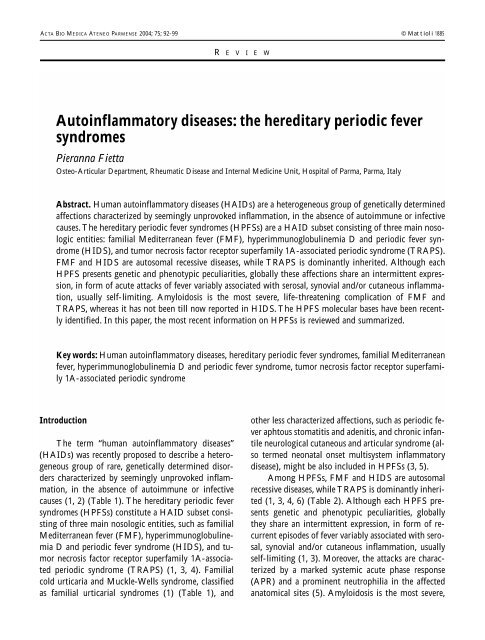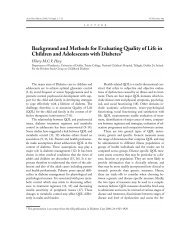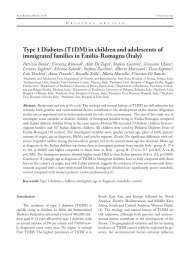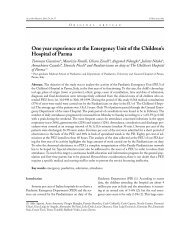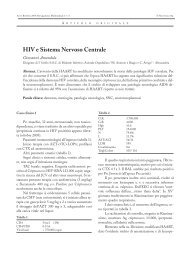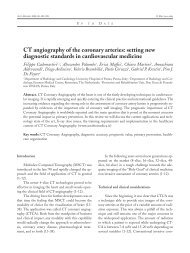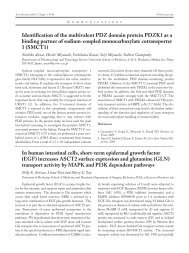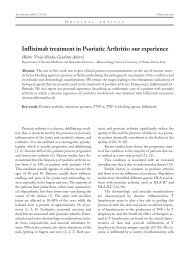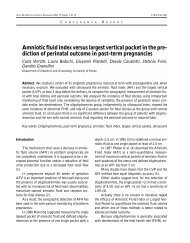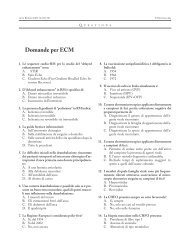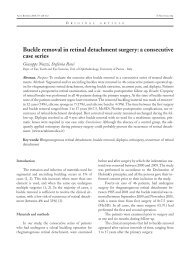Autoinflammatory diseases: the hereditary periodic fever syndromes
Autoinflammatory diseases: the hereditary periodic fever syndromes
Autoinflammatory diseases: the hereditary periodic fever syndromes
- No tags were found...
You also want an ePaper? Increase the reach of your titles
YUMPU automatically turns print PDFs into web optimized ePapers that Google loves.
ACTA BIO MEDICA ATENEO PARMENSE 2004; 75; 92-99 © Mattioli 1885R E V I E W<strong>Autoinflammatory</strong> <strong>diseases</strong>: <strong>the</strong> <strong>hereditary</strong> <strong>periodic</strong> <strong>fever</strong><strong>syndromes</strong>Pieranna FiettaOsteo-Articular Department, Rheumatic Disease and Internal Medicine Unit, Hospital of Parma, Parma, ItalyAbstract. Human autoinflammatory <strong>diseases</strong> (HAIDs) are a heterogeneous group of genetically determinedaffections characterized by seemingly unprovoked inflammation, in <strong>the</strong> absence of autoimmune or infectivecauses. The <strong>hereditary</strong> <strong>periodic</strong> <strong>fever</strong> <strong>syndromes</strong> (HPFSs) are a HAID subset consisting of three main nosologicentities: familial Mediterranean <strong>fever</strong> (FMF), hyperimmunoglobulinemia D and <strong>periodic</strong> <strong>fever</strong> syndrome(HIDS), and tumor necrosis factor receptor superfamily 1A-associated <strong>periodic</strong> syndrome (TRAPS).FMF and HIDS are autosomal recessive <strong>diseases</strong>, while TRAPS is dominantly inherited. Although eachHPFS presents genetic and phenotypic peculiarities, globally <strong>the</strong>se affections share an intermittent expression,in form of acute attacks of <strong>fever</strong> variably associated with serosal, synovial and/or cutaneous inflammation,usually self-limiting. Amyloidosis is <strong>the</strong> most severe, life-threatening complication of FMF andTRAPS, whereas it has not been till now reported in HIDS. The HPFS molecular bases have been recentlyidentified. In this paper, <strong>the</strong> most recent information on HPFSs is reviewed and summarized.Key words: Human autoinflammatory <strong>diseases</strong>, <strong>hereditary</strong> <strong>periodic</strong> <strong>fever</strong> <strong>syndromes</strong>, familial Mediterranean<strong>fever</strong>, hyperimmunoglobulinemia D and <strong>periodic</strong> <strong>fever</strong> syndrome, tumor necrosis factor receptor superfamily1A-associated <strong>periodic</strong> syndromeIntroductionThe term “human autoinflammatory <strong>diseases</strong>”(HAIDs) was recently proposed to describe a heterogeneousgroup of rare, genetically determined disorderscharacterized by seemingly unprovoked inflammation,in <strong>the</strong> absence of autoimmune or infectivecauses (1, 2) (Table 1). The <strong>hereditary</strong> <strong>periodic</strong> <strong>fever</strong><strong>syndromes</strong> (HPFSs) constitute a HAID subset consistingof three main nosologic entities, such as familialMediterranean <strong>fever</strong> (FMF), hyperimmunoglobulinemiaD and <strong>periodic</strong> <strong>fever</strong> syndrome (HIDS), and tumornecrosis factor receptor superfamily 1A-associated<strong>periodic</strong> syndrome (TRAPS) (1, 3, 4). Familialcold urticaria and Muckle-Wells syndrome, classifiedas familial urticarial <strong>syndromes</strong> (1) (Table 1), ando<strong>the</strong>r less characterized affections, such as <strong>periodic</strong> <strong>fever</strong>aphtous stomatitis and adenitis, and chronic infantileneurological cutaneous and articular syndrome (alsotermed neonatal onset multisystem inflammatorydisease), might be also included in HPFSs (3, 5).Among HPFSs, FMF and HIDS are autosomalrecessive <strong>diseases</strong>, while TRAPS is dominantly inherited(1, 3, 4, 6) (Table 2). Although each HPFS presentsgenetic and phenotypic peculiarities, globally<strong>the</strong>y share an intermittent expression, in form of recurrentepisodes of <strong>fever</strong> variably associated with serosal,synovial and/or cutaneous inflammation, usuallyself-limiting (1, 3). Moreover, <strong>the</strong> attacks are characterizedby a marked systemic acute phase response(APR) and a prominent neutrophilia in <strong>the</strong> affectedanatomical sites (5). Amyloidosis is <strong>the</strong> most severe,
<strong>Autoinflammatory</strong> <strong>diseases</strong>: <strong>the</strong> <strong>hereditary</strong> <strong>periodic</strong> <strong>fever</strong> <strong>syndromes</strong>93Table 1. Proposed classification of <strong>the</strong> human autoinflammatory<strong>diseases</strong> (1)Hereditary <strong>periodic</strong> <strong>fever</strong> <strong>syndromes</strong>Familial Mediterranean <strong>fever</strong>Hyperimmunoglobulinemia D and <strong>periodic</strong> <strong>fever</strong> syndromeTumor necrosis factor receptor superfamily 1A-associated<strong>periodic</strong> syndromeFamilial urticarial <strong>syndromes</strong>Familial cold urticariaMuckle-Wells syndromeComplement disordersHereditary angioedemaGranulomatous disordersChronic granulomatous synovitis with uveitis and cranialneuropathy (Blau syndrome)Metabolic disordersGoutFamilial chondrocalcinosis (pseudogout)Storage <strong>diseases</strong>Gaucher’s diseaseHermansky-Pudlak syndromeFibrosing disordersIdiopathic pulmonary fibrosisVasculitic <strong>syndromes</strong>Behçet’s diseaselife-threatening complication of both FMF and TRA-PS, whereas it has not been till now reported in HIDS(3) (Table 2). Often such affections remain unrecognizedand undiagnosed for years and <strong>the</strong> patient’s historyencompasses extensive diagnostic investigations,including laparoscopies or laparotomies. The HPFSmolecular bases have been described only in <strong>the</strong> lastdecades. In this paper, <strong>the</strong> most recent information onHPFSs is reviewed and summarized.Familial Mediterranean <strong>fever</strong>FMF, <strong>the</strong> most common and <strong>the</strong> longest knownHPFS, is an autosomal recessive disease affecting predominantly<strong>the</strong> populations surrounding <strong>the</strong> Mediterraneanbasin, such as Jews (mostly Sephardic), Armenians,Turks and Arabs, but well-documented cases innon-Mediterranean ethnic groups have also been reported(7). FMF generally develops in childhood oradolescence (7). A late-onset usually corresponds to aclinically more benign disease (8). The affection occursin form of recurrent acute episodes of <strong>fever</strong>, variablyassociated with serosal, synovial and cutaneous inflammation,usually lasting from 12 to 96 hours andspontaneously subsiding (3,7) (Table 2). Flares may beprecipitated by menses, emotional stress, exercise, infectionsor surgery (7). Fever is generally above 38°C,with a rapid rise accompanied by chills. Constitutionalsymptoms are common (9). The sterile serositis is representedmostly by peritonitis and pleurisy, rarely bypericarditis or acute scrotum (3, 7, 9) (Table 2).Among cutaneous signs, <strong>the</strong> erysipelas-like ery<strong>the</strong>ma,usually unilateral and located on <strong>the</strong> extensor surfaceof <strong>the</strong> leg, ankle or foot dorsum, is regarded as pathognomonic(3, 7, 9). Severe, protracted myalgia is infrequent(3, 7). Non-erosive monoarthritis with effusion,affecting mostly leg large joints, is common and maybe <strong>the</strong> sole manifestation of an attack in 75% of patients(3, 7). Chronic destructive arthritis (predominantlyin hips or knees) or migratory polyarthritis areinfrequent (3, 7). An unusual manifestation is spondylarthropathy,always HLA-B27 negative and with minimalradiographic spinal involvement (10). The mostsevere manifestation of FMF is <strong>the</strong> development ofamyloidosis, due to <strong>the</strong> serum amyloid A (SAA) depositionin various organs, with kidney predilection(7). Notably, amyloidosis may occur independently of<strong>the</strong> disease severity, and in phenotype II constitutes<strong>the</strong> FMF presenting manifestation (7, 9, 11). The incidenceof this phenotype ranges from 7% to 25% of<strong>the</strong> patients with amyloidosis (11).FMF is due to recessive mutations in <strong>the</strong> MEFV(for MEditerranean FeVer) gene, located on <strong>the</strong> shortarm of <strong>the</strong> chromosome 16 (16p13.3), consisting of 10exons and 781 codons (12). The type and combinationof <strong>the</strong> mutations define a severely or weakly expressedphenotype (phenotype I) (13-15), but, on <strong>the</strong> o<strong>the</strong>rhand, subjects carrying two mutations may not express<strong>the</strong> disease (phenotype III) (16). The mutation penetranceis probably incomplete in females, being <strong>the</strong>male : female ratio greater than 1 (7). At present, morethan forty mutations have been detected, mostly ofmissense type, among which M694V (replacement of
94 P. FiettaTable 2. Salient features of <strong>hereditary</strong> <strong>periodic</strong> <strong>fever</strong> <strong>syndromes</strong>Clinical features FMF HIDS TRAPSEthnic background Jewish, Armenian, Arab, Dutch, French, Nor<strong>the</strong>rn European and anyTurkish o<strong>the</strong>r European ethnicityInheritance Autosomal recessive Autosomal recessive Autosomal dominantUnderlying gene MEFV (chr 16p13) MVK (chr 12q24) TNFRSF1A (chr 12p13)Gene product Marenostrin/pyrin Mevalonate kinase TNF receptor 1AAge at onset (yrs)
96 P. Fiettain HIDS, amyloidosis has not been till now reportedand pleural involvement or myalgias are rare (36). During<strong>the</strong> acute episodes, leukocytosis with neutrophiliaand an intense APR occur, with a significant elevationof serum CRP, SAA, IL-6, TNF-α, IFN-γ, IL-1 receptorantagonist and both sTNFRSF1A and 1B levels(37, 38). Between attacks, stimulated peripheralblood mononuclear cells of HIDS patients in vitroproduce increased TNF-α and IL-1β amounts (39). Apersistent polyclonal hyperimmunoglobulinemia D(>100 U/ml) is <strong>the</strong> hallmark of <strong>the</strong> disorder (3, 35), despitenormal or low levels have been reported in somepatients (36). More than 80% of patients have also highIgA serum levels (3). An elevated urinary excretionof neopterin, a marker of activated cellular immune response,reflects <strong>the</strong> disease activity (40).HIDS is caused by recessive mutations in mevalonatekinase (MK, ATP: mevalonate 5-phosphotransferase)gene (MVK) at long arm of chromosome 12(12q24), encoding an enzyme predominantly localizedin peroxisomes and involved in cholesterol and isoprenoidbiosyn<strong>the</strong>sis (38, 41). The large majority of patientsare compound heterozygotes for two mutations,mostly of missense type, but deletion, absence of an alleleexpression, as well as novel polymorphisms havealso been found (41). The most prevalent is V377I, originatingfrom a common ancestor, likely of Dutch origin(42). In HIDS, <strong>the</strong> mutations determine a decreasedMK activity, however not so profound as in mevalonicaciduria, an affection characterized by a nearcompleteMK defect and a more severe clinical presentation,with episodic <strong>fever</strong>, dysmorphisms and mentalretardation (43). In both <strong>diseases</strong>, <strong>the</strong> MK defect causesincreased plasma levels of mevalonic acid, which isexcreted in enhanced amounts in <strong>the</strong> urine (41, 44).However, <strong>the</strong> relationship between isoprenoid endproductdeficiency and HIDS features is not completelyunderstood. Likely, <strong>the</strong> impaired prenylation ofproteins involved in <strong>the</strong> ligand-induced cellular activationmay have a role in <strong>the</strong> pro-inflammatory cytokinehyper-production that characterizes HIDS (45).At present, <strong>the</strong>re is no completely effective treatmentfor HIDS. If <strong>the</strong> excess of mevalonic acid was<strong>the</strong> cause of symptoms, <strong>the</strong> treatment with statinscould be beneficial. Instead, <strong>the</strong> experience with statinshas been disappointing, with severe inflammatoryattacks apparently provoked by <strong>the</strong> drug (3). There aresome anedoctal reports of benefits with nonsteroidalanti-inflammatory drugs (NSAIDs), corticosteroids,intravenous immunoglobulins, colchicine, cyclosporine,but not widely confirmed (3). In a recent trial, thalidomidehas failed to reduce <strong>the</strong> disease activity (46).Etanercept reduces <strong>the</strong> frequency of <strong>the</strong> flares and attenuates,but not suppresses, <strong>the</strong> HIDS clinical manifestations(47).Tumor necrosis factor receptor superfamily 1A-associated<strong>periodic</strong> syndromeTRAPS, formerly known as familial Hibernian<strong>fever</strong>, is a rare autosomal dominantly inherited HPFS,usually affecting Caucasians, mostly of nor<strong>the</strong>rn Europeanancestry, although recent reports highlight thatit is more common worldwide than previously appreciated(48). TRAPS was first described as a distinctnosologic entity in 1999 (49). The affection has relapsingand remitting nature, and <strong>the</strong> disease onsettends to be later and <strong>the</strong> duration of <strong>the</strong> attacks longerthan in o<strong>the</strong>r HPFSs (Table 2), with marked variabilityeven within <strong>the</strong> same family (6). The episodesusually last a week or more (48, 50, 51) (Table 2) and,sometimes, patients may experience a nearly continuousinflammation (1). The flares may be triggeredby emotional stress, exercise or physical trauma (6,50).Pregnancy can improve TRAPS symptomatology,whereas menses may exacerbate it (6) and post-partumhormonal state may induce attacks (50). The observedmale : female ratio is of 3 : 2, without genderspecificdifferences in phenotypic expression (6). Patientswith TRAPS present high-grade <strong>fever</strong> withchills, variably associated with sterile serositis,conjunctivitis, skin rash, arthralgia, and severe myalgias,which are nearly always present (6,48) (Table 2).Fever is practically constant in childhood, but may beabsent during some attacks in adults (6). Severe abdominalpain with nausea and vomiting is common andpleurisy is frequent. Testicular and scrotal pain may bepresent (6). An increased incidence of inguinal herniaamong men in some families has been reported (6).Distinguishing clinical features from o<strong>the</strong>r HPFSs aremono- or bilateral painful conjunctivitis and/or pe-
<strong>Autoinflammatory</strong> <strong>diseases</strong>: <strong>the</strong> <strong>hereditary</strong> <strong>periodic</strong> <strong>fever</strong> <strong>syndromes</strong>97riorbital edema, as well as severe pain and tightness oftrunk or limb muscle groups, that begin proximallyand move distally (6, 51) (Table 2). Patients often describe<strong>the</strong> discomfort as severely disabling (6). Theskin involvement is common and mostly occurs on <strong>the</strong>limbs as a painless, non-pruritic centrifugally migratorymacular eruption, often overlying <strong>the</strong> area ofmyalgia (6,51). Arthralgia of large joints is common,but a frank arthritis is infrequent (3). When it occurs,arthritis is monoarticular, non-erosive and affects primarilylarge joints (6).TRAPS is due to mutations in <strong>the</strong> TNFRSF1Agene on chromosome 12 (12p13), consisting of 10exons and encoding for TNFRSF1A (1,6). To date, atleast 24 mutations, mostly of missense type, have beenidentified (52), generally located within <strong>the</strong> first or <strong>the</strong>second cysteine-rich N-terminal extracellular domain(CRD1 and 2) of <strong>the</strong> receptor. Although not all carrierpatients present symptoms (3), CRD substitutionsdemonstrate a higher penetrance and increase <strong>the</strong> probabilityof developing amyloidosis (6). However, patientswith sporadic TRAPS may be negative for TN-FRSF1A mutations, probably carrying so far unidentifiedsusceptibility genes (53, 54).The impaired cleavage of <strong>the</strong> TNFRSF1A ectodomainupon cellular activation and <strong>the</strong> consequentreduction in plasma levels of <strong>the</strong> soluble receptor, thatis <strong>the</strong> disease hallmark, have been proposed as apathogenic mechanism underlying <strong>the</strong> hyper-inflammatoryresponse in TRAPS (6, 49). In patients, <strong>the</strong>sTNFRSF1A plasma values are usually significantlylower than in controls not only during attacks, but alsobetween <strong>the</strong>m (6), and may vary according to <strong>the</strong>degree of inflammatory activity (54). Moreover, during<strong>the</strong> flares, laboratory findings include leukocytosiswith neutrophilia and a very high APR, often persistingbetween symptomatic episodes (6). The 25% ofTRAPS patients develop amyloidosis. The attack durationand severity, as well as <strong>the</strong> type of mutations,are risk factors of this complication (49, 51, 54), which,however, does not occur in all <strong>the</strong> affected componentsof <strong>the</strong> same family, suggesting that not yet-characterizedmodifier genes o<strong>the</strong>r than TNFRSF1A maybe involved in modulating <strong>the</strong> disease expression (51).Generally TRAPS patients respond poorly to <strong>the</strong>NSAIDs and colchicine treatment, showing a significantimprovement with corticosteroids (usually morethan 20 mg of prednisone), which are usually ineffectivein FMF (1, 6, 48, 51, 55). The response to corticosteroidsis initially dramatic, but decreases with time,requiring higher doses (3). Azathioprine, methotrexate,cyclosporine, tacrolimus, cyclophosphamideand thalidomide do not give clear clinical benefit (55).Etanercept does not abolish completely <strong>the</strong> inflammatoryattacks, but improves <strong>the</strong> disease activity, decreasing<strong>the</strong> severity, duration and frequency of flares, andallows corticosteroid reduction (55). Moreover, it hasbeen reported that etanercept can reverse renal amyloidosisand prevent its recurrence (6).ConclusionsHPFSs are an amazing group of autoinflammatory<strong>diseases</strong>, frequently under-diagnosed. Althougheach of <strong>the</strong>m recognizes a specific genetic backgroundand phenotypic peculiarities, HPFSs globally express<strong>the</strong>mselves in form of intermittent, apparently unprovokedepisodes of <strong>fever</strong> and inflammation. It is intriguingthat genetically and biochemically so differentaffections share a quite similar clinical expression.FMF is induced by recessive mutations of MEFVgene, coding for <strong>the</strong> pyrin protein, likely involved in<strong>the</strong> innate immune response. It has been speculatedthat pyrin acts as a transcription factor regulating <strong>the</strong>PMN inflammatory response. HIDS is due to recessivemutations of MVK gene, causing a MK defect anda consequently reduced biosyn<strong>the</strong>sis of isoprenoids,likely involved in <strong>the</strong> regulation of <strong>the</strong> pro-inflammatorycytokine production. Resolving <strong>the</strong> completephysiopathology of HIDS is a major challenge to givenew insight into <strong>the</strong> role of isoprenoids in inflammation,as well as to provide novel <strong>the</strong>rapeutic options.TRAPS depends on dominant mutations of TNFR-SF1A gene and is <strong>the</strong> first example of a new pathogenicmechanism for a human disease, based on impairedcytokine receptor clearance.However, in a substantial number of patientswith <strong>periodic</strong> <strong>fever</strong>, a specific syndrome and presentlyknown mutations cannot be identified. It is likely thatsome of <strong>the</strong>se patients will have defects in genes encodingo<strong>the</strong>r pro-inflammatory molecules.
98 P. FiettaFur<strong>the</strong>r studies on <strong>the</strong> autoinflammatory <strong>diseases</strong>promise to extend our understanding on <strong>the</strong> fascinatingmolecular basis of <strong>the</strong> inflammation pathway.AddendumAt <strong>the</strong> time of <strong>the</strong> revision of <strong>the</strong> gallery proofs, Simon A,et al (Clin Pharmacol Ther 2004; 75: 476-83) have reported <strong>the</strong>results of a double-blind study on simvastatin (80 mg/daily)treatment in six HIDS patients, exiting in a drop of urinarymevalonic acid concentration in all of <strong>the</strong>m and in a decrease of<strong>the</strong> febrile attack length in 5 of 6 patients, without side effects.References1. Galon J, Aksentijevich I, McDermott F, O’Shea JJ, KastnerDL. TNFRSF1A mutations and autoinflammatory <strong>syndromes</strong>.Curr Opin Immunol 2000; 12: 479-86.2. Hull KM, Shoham N, Chae JJ, Aksentijevich I, KastnerDL. The expanding spectrum of systemic autoinflammatorydisorders and <strong>the</strong>ir rheumatic manifestations. Curr OpinRheumatol 2003; 15: 61-9.3. Drenth JPH, van der Meer JWM. Hereditary <strong>periodic</strong> <strong>fever</strong>.N Engl J Med 2001; 345: 1748-57.4. Delpech M, Grateau G. Genetically determined recurrent<strong>fever</strong>s. Curr Opin Immunol 2001; 13: 539-42.5. Gumucio DL, Diaz A, Schaner P, et al. Fire and ICE: <strong>the</strong>role of pyrin domain-containing proteins in inflammationand apoptosis. Clin Exp Rheumatol 2002; 20 (Suppl. 26):S45-S53.6. Hull KM, Drewe E, Aksentijevich I, et al. The TNF receptor-associated<strong>periodic</strong> syndrome (TRAPS). Emerging conceptsof an autoinflammatory disorder. Medicine (Baltimore)2002; 81: 349-68.7. Orbach H, Ben-Chetrit E. Familial Mediterranean <strong>fever</strong>. Areview and update. Minerva Med 2001; 92: 421-30.8. Rozenbaum M, Rosner I. The clinical features of familialMediterranean <strong>fever</strong> of elderly onset. Clin Exp Rheumatol1994; 12: 347-8.9. Livneh A, Langevitz P, Zemer D, et al. The changing faceof familial Mediterranean <strong>fever</strong>. Semin Arthritis Rheum1996; 26: 612-27.10. Langevitz P, Livneh A, Zemer D, Shemer Y, Pras M. Seronegativespondyloarthropathy in familial Mediterranean <strong>fever</strong>.Semin Arthritis Rheum 1997; 27: 67-72.11. Mehkoglu M, Ozdogan H, Korkmaz C, et al. A survey ofphenotype II in familial Mediterranean <strong>fever</strong>. Ann RheumDis 2000; 59: 910-3.12. Pras E, Aksentijevich I, Gruberg L, Balow JE Jr, Prosen L,Dean M. Mapping of a gene causing familial Mediterranean<strong>fever</strong> to <strong>the</strong> short arm of chromosome 16. N Engl J Med1992; 326: 1509-13.13. Dodé C, Pécheux C, Cazeneuve C, et al. Mutations in <strong>the</strong>MEFV gene in a large series of patients with a clinical diagnosisof familial Mediterranean <strong>fever</strong>. Am J Med Genet2000; 92: 241-6.14. Gershoni-Baruch R, Brik R, Shinavi M, Livneh A. The differentcontribution of MEFV mutant alleles to <strong>the</strong> clinicalprofile of familial Mediterranean <strong>fever</strong>. Eur J Hum Genet2002; 10: 145-9.15. Ben-Chetrit E. Familial Mediterranean <strong>fever</strong> (FMF) andrenal AA amyloidosis. Phenotype-genotype correlation,treatment and prognosis. J Nephrol 2003; 16: 431-4.16. Kogan A, Shinar Y, Lidar M, et al. Common MEFV mutationsamong Jewish ethnic groups in Israel: high frequencyof carrier and phenotype III states and absence of a perceptiblebiological advantage for <strong>the</strong> carrier state. Am J Med Genet2001; 102: 272-6.17. Ben-Chetrit E, Lerer I, Malamud E, Domingo C, AbeliovichD. The E148Q mutation in <strong>the</strong> MEFV gene: is it a disease-causingmutation or a sequence variant? Hum Mutat2000; 15: 385-6.18. Dewalle M, Domingo C, Rozenbaum M, et al. Phenotypegenotypecorrelation in Jewish patients suffering from familialMediterranean <strong>fever</strong>. Eur J Hum Genet 1998; 6: 95-7.19. Touitou I, Picot MC, Domingo C, et al. The MICA regiondetermines <strong>the</strong> first modifier locus in familial Mediterranean<strong>fever</strong>. Arthritis Rheum 2001; 44: 163-9.20. Cazeneuve C, Ajrapctyan H, Papin S, et al. Identification ofMEFV-independent modifying genetic factors for familialMediterranean <strong>fever</strong>. Am J Hum Genet 2000; 67: 1136-43.21. Aldea A, Campistol JM, Arostegui JI, et al. A severe autosomal-dominant<strong>periodic</strong> inflammatory disorder with renalAA amyloidosis and colchicine resistance associated to <strong>the</strong>MEFV H478Y variant in a Spanish kindred: an unusual familialMediterranean <strong>fever</strong> phenotype or ano<strong>the</strong>r MEFVassociated<strong>periodic</strong> inflammatory disorder? Am J Med Genet2004; 124A: 67-73.22. Centola M, Wood G, Frucht DM, et al. The gene for familialMediterranean <strong>fever</strong>, MEFV, is expressed in earlyleukocyte development and is regulated in response to inflammatorymediators. Blood 2000; 95: 3223-31.23. Shoham NG, Centola M, Mansfield E, et al. Pyrin binds<strong>the</strong> PSTPIP1/CD2BP1 protein, defining familial Mediterranean<strong>fever</strong> and PAPA syndrome as disorders in <strong>the</strong> samepathways. Proc Natl Acad Sci USA 2003; 100: 13501-6.24. Aypar E, Ozen S, Okur H, Kutluk T, Besbas N, BakkalogluA. Th1 polarization in familial Mediterranean <strong>fever</strong>. J Rheumatol2003; 30: 2011-3.25. Notarnicola C, Didelot MN, Seguret F, Demaille J,Touitou I.Enhanced cytokine mRNA levels in attack-free patients withfamilial Mediterranean <strong>fever</strong>. Genes Immun 2002; 3: 43-5.26. Kiraz S, Ertenli I, Ozturk MA, et al. Increased soluble FASsuggests delayed apoptosis in familial Mediterranean <strong>fever</strong>complicated with amyloidosis. J Rheumatol 2003; 30: 313-5.27. Centola M, Aksentijevich I, Kastner DL. The <strong>hereditary</strong><strong>periodic</strong> <strong>fever</strong> <strong>syndromes</strong>: molecular analysis of a new familyof inflammatory <strong>diseases</strong>. Hum Mol Genet 1998; 7: 1581-8.28. Livneh A, Langevitz P, Zemer D, et al. Criteria for <strong>the</strong> diagnosisof familial Mediterranean <strong>fever</strong>. Arthritis Rheum1997; 40: 1879-85.29. Korkmaz C, Ozdogan H, Kasapcopur O, Yazici H. Acutephase response in familial Mediterranean <strong>fever</strong>. Ann RheumDis 2002; 61: 79-81.
<strong>Autoinflammatory</strong> <strong>diseases</strong>: <strong>the</strong> <strong>hereditary</strong> <strong>periodic</strong> <strong>fever</strong> <strong>syndromes</strong>9930. Gang N, Drenth JP, Langevitz P, et al. Activation of <strong>the</strong> cytokinenetwork in familial Mediterranean <strong>fever</strong>. J Rheumatol1999; 26: 890-7.31. Baykal Y, Saglam K, Yilmaz MI, Taslipinar A, Akinci SB,Inal A. Serum sIL-2r, IL-6, IL-10 and TNF-alpha levels infamilial Mediterranean <strong>fever</strong> patients. Clin Rheumatol 2003;22: 99-101.32. Medlej-Hashim M, Petit I, Adib S, et al. Familial Mediterranean<strong>fever</strong>: association with elevated IgD plasma levelswith specific MEFV mutations. Eur J Hum Genet 2001; 9:849-54.33. Ben-Chetrit E, Levy M. Colchicine update – 1998. SeminArthritis Rheum 1998; 28: 48-59.34. Tunca M, Ben-Chetrit E. Familial Mediterranean <strong>fever</strong> in2003. Pathogenesis and management. Clin Exp Rheumatol2003; 21 (Suppl. 30): S49-S52.35. Frenkel J, Houten SM, Waterham HR, et al. Mevalonate kinasedeficiency and Dutch type <strong>periodic</strong> <strong>fever</strong>. Clin ExpRheumatol 2000; 18: 525-32.36. Livneh A, Drenth JP, Klasen IS, et al. Familial Mediterranean<strong>fever</strong> and hyperimmunoglobulinemia D syndrome:two <strong>diseases</strong> with distinct clinical, serologic and genetic features.J Rheumatol 1997; 24: 1558-63.37. Drenth JP, van Deuren M, van der Velde Visser S,Schalkwijk CG, van der Meer JW. Cytokine activation duringattacks of <strong>the</strong> hyperimmunoglobulinemia D and <strong>periodic</strong><strong>fever</strong> syndrome. Blood 1995; 85: 3586-93.38. Drenth JP, Cuisset L, Grateau G, et al. Mutations in <strong>the</strong> geneencoding mevalonate kinase cause hyper-IgD and <strong>periodic</strong><strong>fever</strong> syndrome. International Hyper-IgD Study Group.Nat Genet 1999; 22: 178-81.39. Frenkel J, Rijkers GT, Mandey SH, et al. Lack of isoprenoidproducts raises ex vivo interleukin-1beta secretion in hyperimmunoglobulinemiaD and <strong>periodic</strong> <strong>fever</strong> syndrome.Arthritis Rheum 2002; 46: 2794-803.40. Drenth JP, Powell RJ, Brown NS, van der Meer JW. Interferon-gammaand urine neopterin in attacks of hyperimmunoglobulinemiaD and <strong>periodic</strong> <strong>fever</strong> syndrome. Eur J ClinInvest 1995; 25: 683-6.41. Cuisset L, Drenth JP, Simon A, et al. Molecular analysis ofMVK mutations and enzymatic activity in hyper IgD and<strong>periodic</strong> <strong>fever</strong> syndrome. Eur J Hum Genet 2001; 9: 260-6.42. Simon A, Mariman EC, van der Meer JWM, Drenth JP.Major mutation of <strong>the</strong> hyper-IgD and <strong>periodic</strong> <strong>fever</strong> syndromeoriginates from one common ancestor - truly Dutchtype <strong>periodic</strong> <strong>fever</strong>? Clin Exp Rheumatol 2002; 20 (Suppl.26): S-74.43. Hoffmann GF, Charpentier C, Mayatepek E, et al. Clinicaland biochemical phenotype in 11 patients with mevalonicaciduria. Pediatrics 1993; 91: 915-21.44. Houten SM, Kuis W, Duran M, et al. Mutations in MVK,encoding mevalonate kinase, cause hyperimmunoglobulinemiaD and <strong>periodic</strong> <strong>fever</strong> syndrome. Nat Genet 1999; 22:175-7.45. Houten SM, Frenkel J, Waterham HR. Isoprenoid biosyn<strong>the</strong>sisin <strong>hereditary</strong> <strong>periodic</strong> <strong>fever</strong> <strong>syndromes</strong> and inflammation.Cell Mol Life Sci 2003; 60: 1118-34.46. Drenth JP, Vonk AG, Simon A, Powell R, van der Meer JW.Limited efficacy of thalidomide in <strong>the</strong> treatment of febrileattacks of <strong>the</strong> hyper-IgD and <strong>periodic</strong> <strong>fever</strong> syndrome: arandomized, double blind, placebo controlled trial. J PharmacolExp Ther 2001; 298: 1221-6.47. Takada K, Aksentijevich I, Mahadevan V, Dean JA, KelleyRI, Kastner DL. Favorable preliminary experience with etanerceptin two patients with <strong>the</strong> hyperimmunoglobulinemiaD and <strong>periodic</strong> <strong>fever</strong> syndrome. Arthritis Rheum 2003; 48:2645-51.48. Hentgen V, Granel B, Dodé C, Cuisset L, Delpech M, GrateauG. Tumor necrosis factor receptor superfamily 1A-associated<strong>periodic</strong> syndrome (TRAPS). Rev Méd Interne2003; 24: 781-5.49. McDermott MF, Aksentijevich I, Galon J, et al. Germlinemutations in <strong>the</strong> extracellular domains of <strong>the</strong> 55kDa TNFreceptor, TNFR1, define a family of dominantly inheritedautoinflammatory <strong>syndromes</strong>. Cell 1999; 97: 133-44.50. McDermott EM, Smillie DM, Powell RJ. Clinical spectrumof familial Hibernian <strong>fever</strong>: a 14-year follow-up study of <strong>the</strong>index case and extended family. Mayo Clin Proc 1997; 72:806-17.51. Dodé C, Cuisset L, Delpech M, Grateau G. TNFRSF1Aassociated<strong>periodic</strong> syndrome (TRAPS), Muckle-Wells syndrome(MWS) and renal amyloidosis. J Nephrol 2003; 16:435-7.52. Sarrauste de Mentière C, Terrière S, Pugnère D, Ruiz M,Demaille J, Touitou I. INFEVERS: <strong>the</strong> Registry for FMFand <strong>hereditary</strong> inflammatory disorders mutations. NucleicAcids Res 2003; 31: 282-5.53. Aksentijevich I, Galon J, Soares M, et al. The tumor-necrosis-factorreceptor-associated <strong>periodic</strong> syndrome: new mutationsin TNFRSF1A, ancestral origins, genotype-phenotypestudy and evidence for fur<strong>the</strong>r genetic heterogeneity of <strong>periodic</strong><strong>fever</strong>s. Am J Hum Genet 2001; 69: 301-14.54. Aganna E, Hammond L, Hawkins PN, et al. Heterogeneityamong patients with tumor necrosis factor receptor-associated<strong>periodic</strong> syndrome phenotypes. Arthritis Rheum 2003;48: 2632-44.55. Drewe E, McDermott EM, Powell PT, Isaacs JD, PowellRJ. Prospective study of anti-tumour necrosis factor receptorsuperfamily 1B fusion protein, and case study of anti-tumournecrosis factor receptor superfamily 1A fusion protein,in tumour necrosis factor receptor associated <strong>periodic</strong> syndrome(TRAPS): clinical and laboratory findings in a seriesof seven patients. Rheumatology 2003; 42: 235-9.Received: 19 January 2004Accepted: 28 June 2004Correspondence: Pieranna Fietta, MDOsteo-Articular Department,Rheumatic Disease and Internal Medicine UnitHospital of ParmaVia Gramsci, 1443100 Parma, Italy.Tel./Fax: 0521.702778E-mail address: farnese15@libero.it


